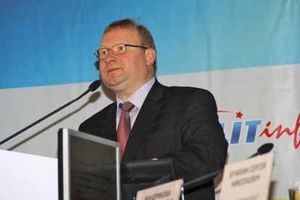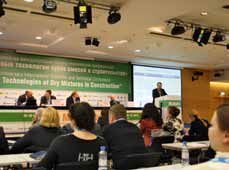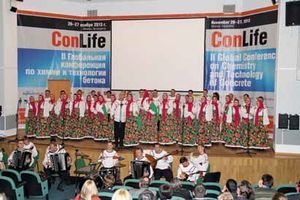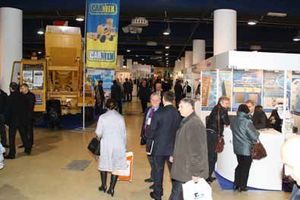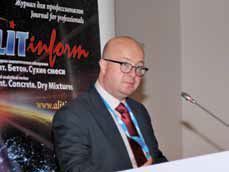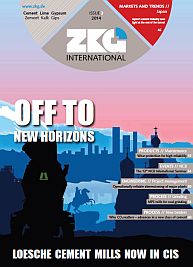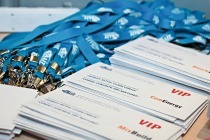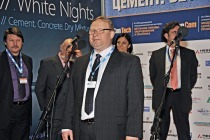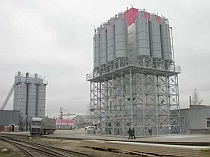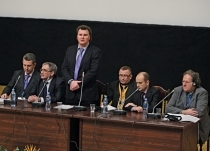Cement.Concrete.Dry Mixtures
In November 2013 the largest Russian Building Forum of “Cement.Concrete.Dry Mixtures” was held in the “Expocentr” in Moscow. 500 experts from twenty-five countries attended the event in the field of building materials and technologies. ALITinform provided the setting for a range of exhibitions, scientific conferences and practically-based papers, in addition to a seminar contest for young scientists.
The forum featured major Russian and foreign companies, including operators of cement works, manufactures of dry mix and constructions materials and applicators. Papers were presented amongst others by the International Federation of Reinforced Concrete (fib), the European Federation of Precast Concrete, Russian Union of Builders, the German Cement Works Association (VDZ) or a huge number of international institutes from Norway, Russia, Germany, the UK, the US, the Netherlands or even from Near and Far East. The Russian State Duma and the Government of Moscow and Moscow Region, Russian Union of builders and Russian Union of cement producers officially sponsored the event as well as Haver&Boecker.
During the exhibition 165 companies from thirteen countries were brought together with leading manufacturers of equipment, materials and related products showcasting their products and services to a large range of visitors, made up primarily of chief technologists, business leaders and decision makers. Every year more and more companies display their equipment and systems at their booths. The relatively new sector of building materials chemistry and dry mortars were presented, too.
The event was officially opened by Eduard L. Bolshakov, President of GC “ALIT”, Chairman of Committee of cement, concrete and dry mixtures of the Russian Builders Union, who sent a warm welcome to the participants of the three-days session and expressed his deepest respect and sincere gratitude to the partners for their invaluable contribution to the development and the organizing of this forum. The Vice-President of the Russian Union of Builders, Sergey Kuchikhin, defined the major goals for the Russian Federation, and outlined possible paths for their achievment. Gordon Clark, President of International Federation for Reinforced Concrete (fib), highlighted some issues of longevity research for the pre-stressed reinforced concrete, including the use of concrete. Patrick Declerck, President of the Federation of the European Precast Concrete Industry (BIBM), provided background information on lobbying and supporting large European organizations.
Special attention was drawn by the report of Eduard Bolshakov who gave the newest data on the market of dry mixtures production and consumption in Russia and foreign countries and gave an outlook on how to expand its application in coarsepored and multifunctional concretes.
The first winner of the International Seminar-Contest for young scientists of 2012, Olga Mandrikova, concluded the plenary session with her focus on binding agents.
One of highlights of the conference program was on chemistry and technology of concrete making “ConLife”. Facing the problems of environmental pollution, greenhouse gases, depletion of natural resources, high energy consumption, scientists and engineers are seeking new ways for the development of the building industry, and shared their experience to develop sufficient business models.
According to the academics opinion such high quality of concrete, energy saving, and ecological improvement are bound to the use of nanotechnologies and help to create a breakthrough in the field of domestic building. In a nutshell it becomes apparent that the sustainable development of concrete building materials would only be possible by the knowledge about modified agents. Johann Plank, of Institute of Construction Chemistry of the TU Munich also drew his attention to the economical features of the modifiers industry in regard to the country or region.
The representative of the Russian scientific school, Lev Dobshits, expressed his view on improvement of building materials quality. In his report he talked about kinetics properties of slow-setting cement mortars and fillers as well as Nele de Belie from Magnel Laboratory for Concrete Research, raised the topic of self-healing concrete, suggesting different explanations of this phenomenon.
John Provis of RILEM, Technical Committee of Durability Testing of Alkali-Activated Materials (DTA) closed the session with the influence of alkali-activated binders on the atmosphere, while Andrey Kalachev, General Director of the “PhoeParallel the “GypMeet” reading took place where amongst other readers Johann Plank introduced his newest findings related to new additives and outlined three major modifiers that can most influence the development of the industry. Hans Ulrich Hummel, Knauf Group, focussed on work on tailor-made plasticizers for stucco-based binder systems. Ebrahim Najafi Kani of Semnan University, Iran presented his work on the effects of additives on water repellent and high strength in gypsum plaster by using organic and inorganic additives. The session was closed by Robert McCaughey, Global Media Ltd., and Mark Flumiani from Innogyps, Canada giving an impression on capacities, activities and shareholder structures of global gypsum companies.
Great interest was generated by the program of the reading “CemRead — Modern Cement Plant”, which becomes a traditional meeting place for the cement process engineers from around the world. As always at the events at this level the representatives of the Russian school raised fundamental questions of science, defining the unique properties of cement-based materials. Their foreign colleagues talked about the application of new technologies in the process of grinding and stokage of raw materials, as well as new scientific approaches contributing to the quality of cement.
Alexey Zubekhin from the South-Russian State Technical University highlighted new aspects concerning the nature of silicates, and Hubert Baier, of WhiteLabel-TandemProjects e.U. and Editor-in-Chief of ZKG INTERNATIONAL, contributed a more in-depth view, based on his operational experiences in pre- and co-processing of alternative fuels in modern cement plants. Yaroslav Stoupa, General Director of LSR Cement, spoke about problems and solutions during the erection and commissioning of a new cement production line. He focused on the smallest details that usually escape the attention of the experts, but can cause major problems such as extremely varying weather conditions resulting in handling of sticky materials. Marc Piccinin, presented a completely fresh view on the grinding equipment for more efficientcy in the cement production process. His company managed to develop a number of practical tools that assits the grinding engineers.
At least a round table was held for producers, distributors and marketing experts confronted in various sectors with the problem of counterfeit products. Within the discussion all the parties concerned not only justified the distribution of the counterfeit products in the market but also shared their own experience in dealing with this phenomenon. In particular, the First Deputy Chairman of the RSPP for technical regulation, standardization and conformity assessment, A. N. Lotsmanov reported on the enforcing requirements of technical regulations. The representative of the Main Department of Economic Security and the Russian Interior Ministry anti-corruption A. A. Maksimov spoke about the work of the Interior Authorities in charge of competitive counterfeit products and its results, while the Patent Attorney K. N. Semenko shared his experince of combating illegally manufactured products, and the legal precedents. Special attention was drawn by the Deputy Director General of NPC “Antikontrafakt” I. Y. Shirokov, he drew attention with his assessment of the impact of counterfeit products on the Russian market. Also the reports delivered by the representatives of the leading manufacturers of the Russian Federation, including the companies Lafarge, Knauf, Eurocement group, who talked about the practical measures taken by organizations for anti-counterfeiting.
In line with Russia’s ancient tradition of generous hospitality, a sumptuous dinner was enjoyed and a magnificent show completed the well organized program, and providing stimuli for deepening of personal contacts around the globe.
Большое спасибо. Ждем Вас на следующей встрече в декабре 2014 года!

